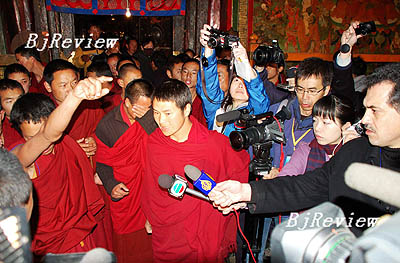|

TEMPLE INTERLUDE: Some monks disrupt an interview by journalists in Jokhang Monastery, Lhasa, to tell their side of the Lhasa riots
The Chinese Government finally opened the door to foreign journalists wanting to enter Tibet on March 26, following days of unrest. The three-day trip was organized by the Information Office of the State Council for selected media organizations, including Hong Kong's South China Morning Post, Britain's Financial Times and the Associated Press from the United States.
On the morning of the second day of the tour, journalists were led to the Jokhang Monastery, one of the most sacred religious sites in Tibet and where the riots on March 14 first began, to interview the lamas. Before this, reporters had been taken to a Tibet medical clinic that had been attacked, and shown a clothing store where five girls had been burned to death by brutal rioters.
Journalists were listening to a briefing by an administrator in the courtyard of the monastery when several young monks suddenly disrupted the meeting shouting, "Don't believe them. They are tricking you. They are telling lies!"
About 30 monks in the courtyard began to close the door to the inner sanctum of the temple in an attempt to prevent anyone from entering. They began talking excitedly to the reporters in Tibetan for about 30 seconds before one journalist asked them to speak Chinese.
Facing clusters of cameras and flashlights some were crying as they told the reporters that the government was lying about the recent unrest. They also rejected that the Dalai Lama clique was behind the rash of protests.
When asked why the monks were crying, one replied, "They feel so sad and uncomfortable to see that the worshippers at the monastery today are staged."
The short monk added that some 100 monks were killed during the riots, and repeated the same line again and again. But when one reporter asked him how he knew this and if he had seen the bodies or had any evidence, he remained silent and went away.
Chinese officials who were on the spot did not stop their interruption, just watching in silence. The monks' denunciation lasted about 15 minutes until the accompanying officials said time was up and asked the reporters to leave for the next stop.
News of the meeting with the monks soon appeared in newspapers, as well as on TV and the Internet.
Videos about the disruption were uploaded onto Youtube, the world's biggest video-sharing website, and attracted divided comments. Some showed their support for the monks, but others were skeptical of their claims.
"If what they said is true, common sense is that they will show photos and sources to shut up the Chinese Government. But they have no evidence, just their words," said one comment from ID Tubeme 352.
On the website of www.onechn.com, established by patriotic overseas Chinese, a still video image taken from footage of the meeting with the monks appeared to show one monk with his head turned laughing, while others wept.
"What they said is not true. They were attempting to mislead the world's opinion. The facts should not be distorted," said Baema Chilain, Vice Chairman of the regional government at a press conference, to domestic and overseas media on the evening of March 27.
China Central Television, the national TV broadcaster, sent a team of reporters to Jokhang Monastery later the same day to hear the short monk's story. But they were flatly refused by the monk saying that he was unable to talk because he had stomachache | 